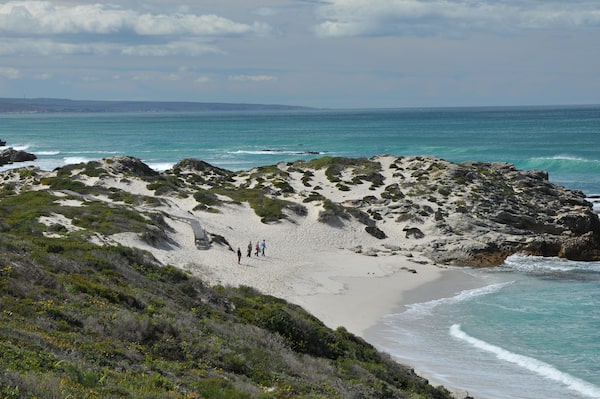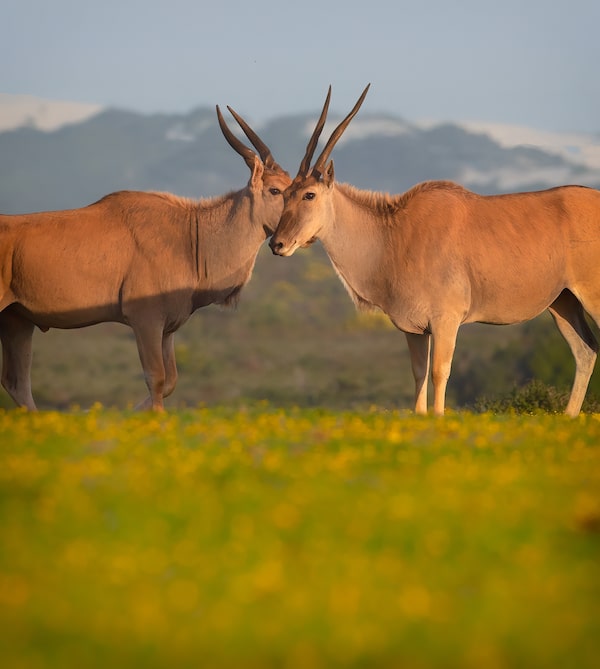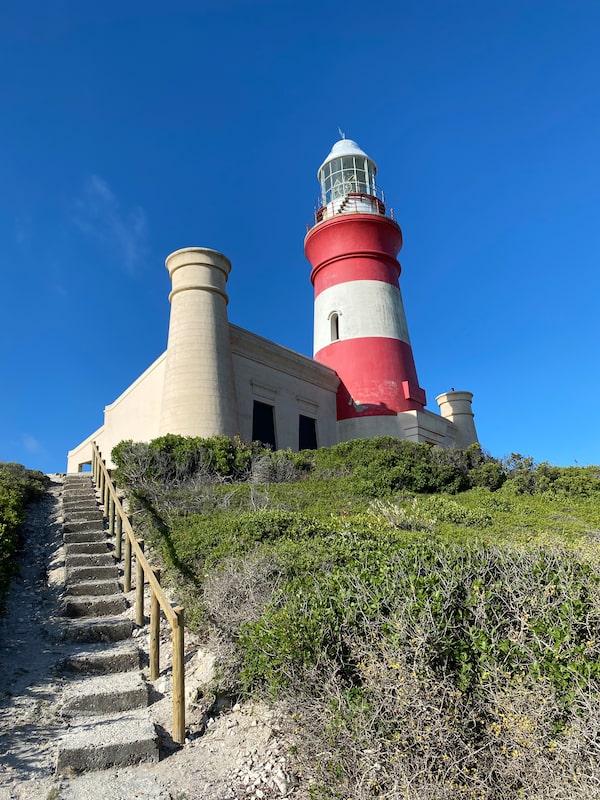De Hoop Nature Reserve in South Africa.Erin Conway-Smith/The Globe and Mail
As you drive into De Hoop Nature Reserve in South Africa’s Western Cape region, you’ll see majestic herds of eland, one of the world’s largest antelopes. You might also catch sight of a few Cape mountain zebra, the endangered cousins of Africa’s famous striped beasts.
But while admiring the charismatic animals here, pay attention to the ungainly ostriches strolling among them. They are a curious link to some of the world’s earliest art, found in the ancient sea caves of the nearby coast.
Abstract geometric designs carved into the giant shells of ostrich eggs around 65,000 years ago are among the oldest known examples of symbolic creations by humans. Dozens of carved fragments have been found in Klipdrift Shelter, an archeological site on the reserve.
A new exhibition at this stark but stunning site calls it a land of “extreme plenty” – a prehistoric coastal paradise where an abundance of shellfish and mammals, along with a mild climate and protective caves, allowed Stone Age humans enough time for the luxury of creating patterns on the eggshells they used as water containers.
Ostrich and egrets at De Hoop Nature Reserve in South Africa.Erin Conway-Smith/The Globe and Mail
This connection to early human history is among the hidden gems of the Western Cape. Most tourists tend to fly into Cape Town and join the crowds on the city’s beaches or the Table Mountain cable car. By venturing off the beaten path, just a few hours in almost any direction from Cape Town, you can discover a host of unexpected pleasures – and often have them almost to yourself.
As South Africa celebrates the 30th anniversary of its first democratic election after its liberation from apartheid, the country is increasingly recognizing the importance of tourism, which supports nearly 10 per cent of its work force. Cape Town, the legislative capital, remains the hub, drawing record numbers of inbound passengers at its airport this year and regularly topping global lists of favourite cities, with its spectacular new museums and waterfront shops. But for a glimpse of the true South Africa, go beyond its limits.
In my 15 years as a Johannesburg-based correspondent, I’ve come to treasure road trips across the country, from mountains to desert to ocean. A vast network of wildlife parks is easily accessible, with comfortable accommodations and good facilities. Roads are not always up to Canadian standards but mostly fine, and South Africans are famously friendly.

De Hoop Nature Reserve was a farm in the 18th and 19th centuries, and its historic homestead was later declared a national monument.Supplied
For our latest five-day meander through back roads and coastal hideaways, we head two hours east of Cape Town to the gorgeous town of Montagu on the edge of the Karoo desert, where we spend the first night.
Montagu is known for its nearby Boer War fort, but nowadays its excellent museum and extensive herb gardens are an entry point to the culture of the Khoisan, the Indigenous people of Southern Africa. The museum, housed in a 117-year-old former church, features displays of medicinal herbs from Indigenous remedies, handed down to generations and studied by the museum’s staff for the past three decades.
A stroll around the historic town reveals many other attractions: good restaurants, an art-deco hotel and hundreds of the African sacred ibises and egrets that roost in the trees above a town pond.
A two-hour drive to the south – past fields of grain, dotted with South Africa’s national bird, the blue crane – brought us to De Hoop. The nature reserve was a farm in the 18th and 19th centuries, and its historic homestead was later declared a national monument. Today the reserve is a successful partnership between the provincially owned CapeNature agency and several private companies that provide cottage-style accommodation, dining and leisure activities.
At low tide, guides bring visitors to rock pools, where you can see the same abundance of shellfish that allowed the early humans to flourish. Whale season is from June to December, bringing southern right whales into the bay. The land-based whale watching here is among the best in the country. For a more adventurous pursuit, you can see whether your snowboarding skills translate to the emerging sport of sandboarding on the massive sand dunes near the ocean.
Endangered birds are protected at De Hoop, making for some extraordinary birdwatching experiences.ANTON CRONE/Supplied
The birdwatching is exceptional. We spotted 45 of the reserve’s 260 bird species in a two-hour walk along De Hoop’s inland lake. There are flocks of pelicans, egrets, cormorants and flamingos. De Hoop is part of the Cape Floral Region, a UNESCO World Heritage site, protected for its thousands of endemic plant species and its unique fynbos vegetation, an exceptionally diverse type of coastal shrub.
Endangered birds are also protected here. De Hoop is home to a newly established colony of African penguins, the latest attempt to stave off the extinction of the continent’s only penguin species. There’s also a colony of Cape vultures – the last surviving in the Western Cape. Neither the penguin colony nor the Klipdrift archeological site are open to visitors, but there are guided walks to the vulture colony to see the endangered birds swooping overhead.

Eland, one of the world’s largest antelopes.Supplied
Because there are no predators in this corner of the country, you can stroll safely among the wildlife: bontebok antelopes, ostriches, otters, rock hyraxes and more. There are good hiking trails along the lake, where spectacular golden orb spiders can be spotted. The reserve is also the end point of the renowned 55-kilometre, five-day Whale Trail, one of South Africa’s most popular coastal hiking routes. (Advance bookings required.)
De Hoop employs about 200 people, providing much-needed jobs in a country of high unemployment. Most employees are local residents from lower-income communities who have been trained into skilled positions.
One of them is Dalfrenzo Laing, from the nearby town of Napier, who survived a troubled adolescence of crime and drug use. In 2008 he was laid off from his job at a petrol station and had no idea what to do. Recruited for an eight-month marine guiding course, he became De Hoop’s first guide.
Ten years ago, when I first visited De Hoop, he was our guide to the starfish and jellyfish at the tidal pools. Today he is assistant general manager for the De Hoop Collection, the company that operates the white-washed cottages and farmhouses where visitors stay, and he serves as its ambassador to the local communities. “I’ve visited many schools and I hope I’ve inspired them,” he told me. “I tell them about my journey and how nature has helped to transform me.”
After two nights at De Hoop, we drove an hour westward to the relaxing coastal town of Agulhas. The big attraction here is Cape Agulhas – the southernmost tip of Africa and the meeting point of the Atlantic and Indian oceans. (Many people wrongly assume that the Cape of Good Hope is the continent’s southern tip.)
Portuguese sailors called it the Cape of Needles in the 1480s after discovering that their compass needles all pointed precisely true north from here. But the name also evokes the sharp rocks and dangerous reefs in the waters of the often-stormy cape, which have wrecked roughly 150 ships over the centuries, giving it another name: the Graveyard of Ships.

One of South Africa’s oldest lighthouses, at the southernmost point in Africa.Geoffrey York/The Globe and Mail
Agulhas National Park is now building an interpretative centre and expanded visitor facilities around the cape’s distinctive 175-year-old lighthouse – one of the oldest in the country, and still functioning. Inside is a small museum, and you can climb to a very windy viewpoint at the top.
The southern tip of Africa, a few hundred metres past the lighthouse, is marked with a monument and a giant stylized map of the continent. A few kilometres down the coast is the Meisho Maru shipwreck, the eerie rusted remains of a Japanese fishing trawler that crashed into the underwater rocks during a storm in 1982.
Another nearby attraction is the town of Struisbaai, with a sandy beach that extends for 14 kilometres (although the water is probably too cold for most swimmers). Stingrays swim into the harbour every day in search of discarded entrails from the fishing boats. The biggest and most popular has been named Parrie.
After an excellent dinner at a fish-and-chips spot and a night at an Agulhas hotel, we drove back to Cape Town, making time along the way to stop for tastings at Africa’s southernmost wineries, including Strandveld and Black Oystercatcher. The terroir for these wine estates produces distinctive sauvignon blancs because of its slow-ripening yields, small grapes and cool Atlantic Ocean winds.
An alternative coastal route back to Cape Town is slightly longer, but it allows you to visit the beguiling town of Hermanus, the country’s whale capital, with its 12-kilometre cliff walk and Whale Crier who alerts tourists with the foghorn-like blare of his kelp horn when there is a sighting.
On the coastal route of this five-day loop, an essential final stop is the town of Betty’s Bay, a former whaling station. Here, you can visit one of South Africa’s best-known colonies of African penguins, giving you a glimpse of the charming but endangered birds that De Hoop’s new colony is trying to revive. Scientists at Betty’s Bay are measuring the diet of these plucky penguins, studying ways to safeguard their future – and keep the tourists coming.
If you go
Cape mountain zebra at De Hoop Nature Reserve.Supplied
There are no direct flights to South Africa from Canada, but there are many flights from cities such as Atlanta, Newark, N.J., London, Paris and Frankfurt, with some flights going directly to Cape Town.
Car rental is easy and efficient at Cape Town airport. Driving is on the left, as in Britain. If you don’t want to self-drive, some tourism agencies allow you to hire a guide with a car.
Visa and Mastercard are widely accepted but carry some South African rands for petrol-station tips, car guards and parking garages. Most ATMs accept international debit cards, but don’t get into conversation with the smooth-talking con men who sometimes hover around the cash machines.
Crime is always a concern, but it is much rarer in small towns and tourist sites, where the vibe is relaxed and friendly. Stay alert in the big cities, keep your car doors locked and windows up, and put valuables in your trunk.
At national parks, you can book comfortable chalets or huts from the excellent website of SANParks, the national parks agency: sanparks.org.
At De Hoop, a range of accommodation, from campsites to six-bed manor houses, is available as part of the De Hoop Collection: dehoopcollection.com
In Agulhas, the Agulhas Country Lodge boasts nice sea views. Rates with breakfast, based on double occupancy, start at $75 a person: agulhascountrylodge.com
In Montagu, sunbirds dart around the gardens of the Montagu Vines Guesthouse. Rooms start at $155 for double occupancy: montaguvines.co.za